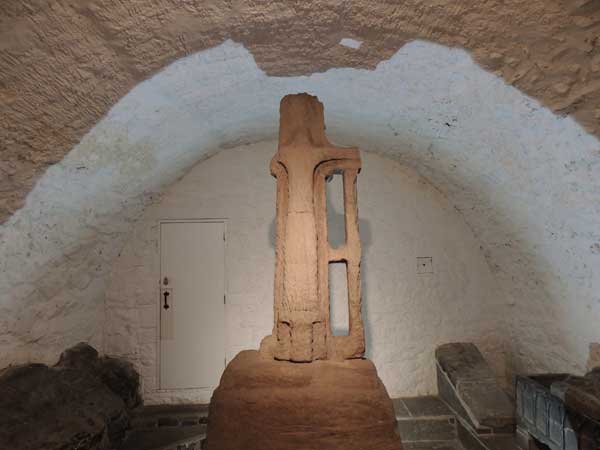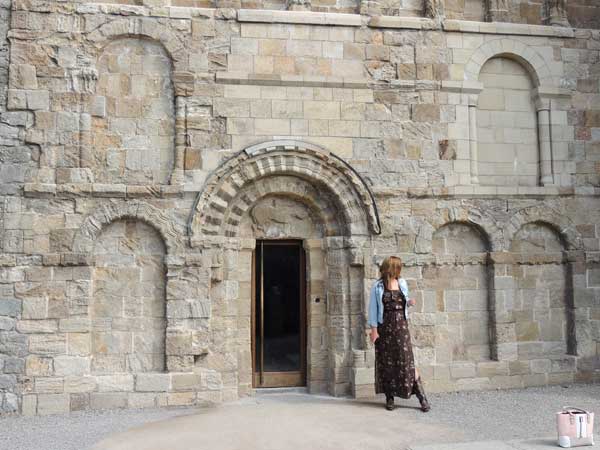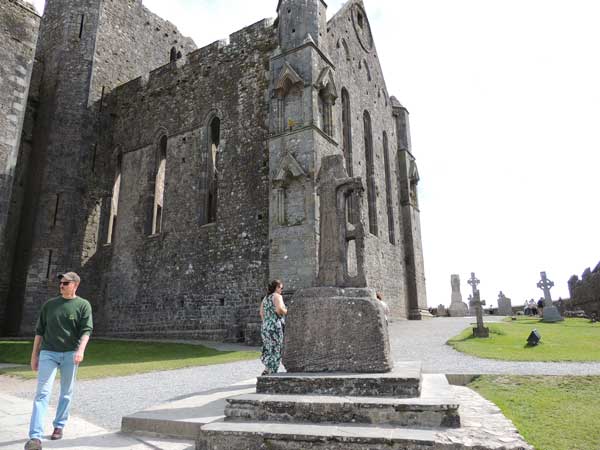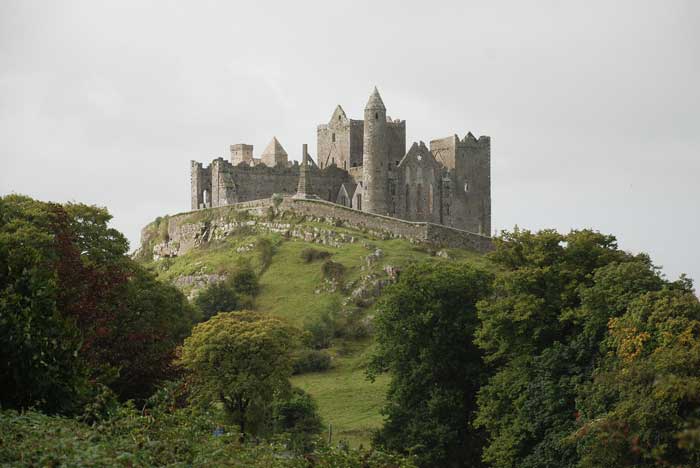The Rock of Cashel is situated in the glorious County Tipperary.
Set high above the town of Cashel in the Golden Vale of Ireland.
The Rock of Cashel looks down protectively over all it surveys.
This epic and mystical architectural wonder is Irelands foremost heritage attraction and has a history that is soaked in the wondrous myths and legends of Ireland.
A symbol of Irish Royalty and Medieval Religious power. Associated with some of Ireland most important historic people, such as Saint Patrick and High King of Ireland Brian Boru.
This limestone rocky outcrop is saturated in over 1000 years of Irish History.
As you approach the Rock of Cashel you will be astounded by the size and epic scale of this ancient monument.
You cannot help but imagine the hardship endured by master medieval builders who would have constructed this wonder that stands looming above you.
The light bouncing off the ancient stones gleaming brightness that illuminates every part of your mind.
The jagged rocks guiding you to an epic building full of wonder and tales of old Ireland.
The Rock of Cashew is known by many names, including St. Patrick Rock and The Rock of Kings.
This epic monument can be seen for miles and has the most spectacular views of County Tipperary’s lush beautiful emerald green landscape. Local Legend say that the Rock of Cashel has its origins in an area of Tipperary known as the Devils Bit.
This is where Saint Patrick banished The Devil from the area, this resulted in the rocks of the cave where he was hiding landing at Cashel creating the Rock formation the historic building of the Rock of Cashel now reside.
The History of The Rock of Cashel
Cashel means stone fort it is assumed that the first building on this site was a stone ring fort known as a Cashel.
It is documented that Cashel in its earliest form was the seat of power and main residence of the Kings of Munster.
Saint Patrick traveled Ireland spreading the world of Christianity to the Pagan Irish.
It is said that he visited the Rock of Cashel in about the year 450AD.
This is when he baptized the King of Munster Oengus Mac Nad Froich into the faith of Christianity.
The Rock of Cashel was the site of the coronations of the High King of Ireland Brian Boru in 964AD.
The grandson of Brian Boru, King Muirchertach Ua Briain, gifted the Rock of Cashel to the Church in 1101.
It is at this time that we start to see the establishment and developed of the Rock of Cashel as a religious site.
The oldest surviving building on this site is the Round Tower, which dates from the 12th Century.
The Rock of Cashel became home to the archbishop and in 1127 the King Bishop of Cashel was Cormac McCarthy commissioned the building of the wondrous building known as Cormac’s Chapel.
The Rock of Cashel is one of the finest examples of Medieval Architecture to survive in the world.
The Norman Conquest of Ireland in 1168 saw the development of Cashel town and the importance of the Rock of Cashel as a religious centre of importance continued.
The Confederate Wars of Ireland saw the sad and blood soaked downfall of the Rock of Cashel.
In 1647 Cashel town and the Rock of Cashel were attacked by parliamentary forces under the brutal command of Count Murray O’Brien.
Roman Catholic establishments were sacked and plundered, it was a time when many priests were murdered.
The Medieval Rock of Cashel became the site of refuge for locals and for Irish Rebel Confederate forces.
About 3000 people took refuge here during this time.
During the final battle a fire broke out on The Rock of Cashel and most of the people taking refuge there were burned alive.
The Rock of Cashel fell into a stare of disrepair over the following centuries and is now being lovingly restored by the Irish Office of Public Works.
What will you see on your visit to the Rock of Cashel
As you approach the Rock of Cashel you know you are about to witness and experience something special, a once in a lifetime experience that will fill your dreams with images of the medieval world.
You are taking a step back in time to the realms of historic kings and events that have been an inspiration to all who have walked thought this mystical monument.
You enter the Rock of Cashel through the Hall of the Vicars Choral, which is a 15th Century building that would have housed the Choristers who’s singing would have graced the Medieval Cathedral.
This historic building is full of historic exhibition and videos for you to absorb before you enter the Medieval religious buildings of the Rock of Cashel.

The Hall of Vicars Choral also contains an undercroft that contains the 12th Century St Patrick’s Cross.
As you leave this spectacular building you are walking into time of medieval wonder and delight.
You will be surrounded by ancient walls and panoramic views.
Walk though mystical gravestones spanning centuries telling the name of those people who were laid to rest surrounded by greatness.
Round Tower of the Rock of Cashel
The Round Tower on The Rock of Cashel is the tallest and oldest surviving building in this dramatic complex of medieval multiphase architecture, dating from the 12th Century.
It is 28m in height and its entrance is notably nearly 4 meters above ground level.
The Round Tower at The Rock of Cashel was constructed using a building technique known as the dry stone method.
Round Towers in Ireland were multi functional. They were primarily Bell Towers, calling the religious communities to pray.
However, there were also places of refuge during times of unrest.
The residents of the complex could pull the rope ladder to the towers entrance up and attackers would not be able to reach those inside.
They were also a place to store and protect the wealth of the religious community.
Cormac’s Chapel at the Rock of Cashel

Cormac’s Chapel is named after King Cormac Mac Carthaigh who commissioned this world famous Chapel in 1127 but it was not officially consecrated until 1134.
When you walk into this magnificent chapel you are completely absorbed by the magnificence of the architecture.
It architecture is just outstanding and combines native Irish and European architectural styles to create a unique and wondrous architectural experience.
The towers on the sides of the nave and chancel have a strong Germanic theme.
There is magnificent arcading on both the exterior and interior of Cormac’s Chapel as well as an epic barrel-vaulted room and carved tympanum over the doorways with beautiful arches.
Cormac’s chapel is mainly constructed of local sandstone, over time water damage occurred within the chapel and there was damage to the frescoes that adorned the chapel, however there has been extensive restoration and preservation work preformed on Cormac’s Chaple preserving these wonders for future generations.
The Cathedral at the Rock of Cashel

The largest and most predominant building on The Rock of Cashel is the absolutely magnificent Cathedral.
This cruciform shaped building was constructed between 1235 and 1270.
Now a ruin it is still one of the most magnificent buildings in Ireland.
As you walk into the Cathedral you can still imagine this glorious building as it once was.
The sky now replaces its roof and soaks the internal areas in glorious rays of light, illuminating its magnificent architectural features.
This is one of the finest pieces of 12th Century religious architecture to service anywhere in the world and it is impossible not to become absorbed in the fascinating past of a building like this, willing it to give you answers to countless questions.
During the Irish Confederate Wars this is the building where civilians, as well as rebels confederate forces too, refuge and were massacred by the Parliamentary forces of Murrough O’Brien the 1st Earl of Inchiquin.
During this time many of the most important religious artifacts would have also been destroyed.
The main cathedral roof was removed in 1749 under the orders of Arthur Price, the Anglican Bishop of Cashel.
Forever reducing this magnificent work of medieval architecture to a ruin.
For anyone visiting our amazing country this is an absolute must see, it is an experience that will stay with every visitor forever.
You feel part of history, where the gothic and Romanesque architecture fill you heart with joy and wonder.
Important Information for your trip to the Rock of Cashel
Contact Details.
Address Saint Patrick’s Rock of Cashel, Cashel, County Tipperary, E25 KX44
Phone +353 62 61437
Email mailto:rockofcashel@opw.ie
Opening Hours.
The Rock of Cashel is open all year.
Mid September – Mid October
Open Daily 0900 – 1730
Last admission is at 1645
Mid October – Mid March
Open Daily 0900 – 1630
Last admission is at 1545
Mid March – June.
Open daily 0900 – 1730
Last admission is at 1645
June– Mid September
Open Daily 0900 – 1900
Last admission is at 1815
The Rock of Cashel is closed from 24th – 26th of December.
Admission
Adult – €8.00
Senior – €6.00
Child/Student – €4.00
Family – €20.00
Group – €6.00 (All group bookings must be booked in advance)
Please Note that a tour of Cormac’s Chapel is by guided tour only and incurs a charge of €3.00 per person.
Tour Information
Tickets can only be purchased on site.
The average length of a visit to the Rock of Cashel is approximately 1 – 1.5 hours.
Guided tours are every hour on the half hour.
The tour last approximately 45 minutes.
Maximum number on each tour is 50.
There is a guidebook available in English and Irish.
There is an information leaflet available in English, German, Italian, Spanish and Polish.
Photography and Video is allowed for personal use only.
It is important that this is one of Ireland’s busiest heritage sites and you may expect to experience delays during the summer months.
Facilities
Public Toilets
Car Parking
Credit Card Facilities.
Rock of Cashel FAQ’s
The Rock of Cashel was home to the Kings of Munster. It was a fortress for the ancient royal families in the 4th and 5th centuries. Two legends in Irish history are famous for the Rock of Cashel, King Aengus who was Ireland’s first Christian ruler and then there was Brian Boru, he was crowned High King of Ireland here in 990.
It costs around €8 for an adult to visit the Rock of Cashel. Seniors pay €6 and €3 for children.
Tours of the Rock of Cashel take around 45 minutes but be expected to spend 75 minutes in total seeing everything when visiting.
The Rock of Cashel is in Cashel Town, County Tipperary. It’s around a 19 minute drive from Tipperary town according to Google Maps. If you’re coming from Dublin it will take around 1 hour and 45 minutes to get there via car.

